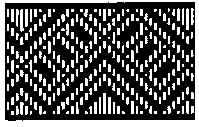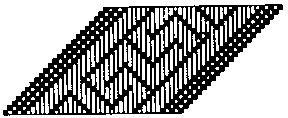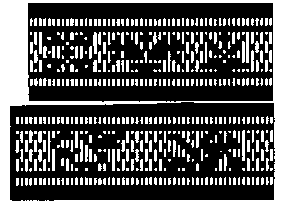 "Bifrons 6A" (originally 3mm wide),
"Bifrons 6A" (originally 3mm wide),
This document is provided as is without any express or implied warranties. While every effort has been taken to ensure the accuracy of the information contained, the author assumes no responsibility for errors or omissions, or for damages resulting from the use of the information contained herein.
Permission is granted to make and distribute verbatim copies of this document for non-commercial private research purposes provided the copyright notice and this permission notice are preserved on all copies.
This article was originally printed in the Pikestaff Arts and Sciences Issue (December 1994), a publication of the East Kingdom of the Society for Creative Anachronism, Inc. Some slight wording changes have been made for the sake of clearer reference to the illustration arrangement that was created during webbing.
Copyright © 1994, 1996, 1997 Carolyn Priest-Dorman.
One of the highlights of many people's event schedules is the opportunity to go shopping. Trim merchants especially seem to draw large crowds of eager shoppers, and with good reason: they provide a relatively inexpensive analogue to those authentic medieval ornaments which would have been prohibitively expensive to make or purchase oneself. This article is for some discriminating early period[1] trim shoppers with a northwestern European persona (Vikings, Franks, and early Saxons, this means you!).
One of the most ostentatious tablet-weaving techniques, metal brocading, was used a great deal in early period to create baldrics, headbands, and trims. Richly colored gold or silver metallic trim is the best modern commercial analogue for brocaded tablet-weaving, and, fortunately for us early period types, almost every trim merchant carries a selection of it.
The first trick of using a trim authentically is to pick out a trim that looks like something from an early period culture, preferably your own. This is not as easy as it sounds. One of the first things you will need to consider is the overall color scheme of the trim. Most of the extant early period tablet-woven brocades have not been tested for dyestuffs, due to their fragmentary state. In many cases, the only part of the band left is the metallic weft. Those few brocades which have been tested usually reveal a bright color--red, blue, or purple--against which the metal weft shows up well. (Heraldry works!) The metal weft itself is always silver or gold in color. Accordingly, it is a good idea when looking for metallic trim to seek out dark rich background colors with silver or gold brocading on them. Vikings seem to have worn much more silver trim than gold. Saxons and Franks, both male and female, appear to have preferred gold: none of the major finds pertaining to these cultures contain silver brocading.
Bright colors seem to have fascinated early period cultures at least as much as they do SCA members. The early period color palette, from Constantinople to Ireland, is pretty much the same: purples and violets from lichen, alkanet, and shellfish; blues from woad; brick reds from madder; rich deep red from kermes (an expensive import in most locations, used for only the finest textiles); yellows from weld or broom; dark golds from saffron or tannin- based sources; greens, purples, and violets from overdyeing. Not a lot of evidence survives for black-dyed textiles in early period, although small amounts of naturally pigmented wools were sometimes used. While browns, rusts, and neutrals were also common colors in early period, they were much less likely to be used on fancy clothing.
The Jutes who settled in Kent (southeastern England) used brocaded trim beginning in the sixth century, probably after having learned it from the Merovingian Franks.[2] Some patterns from brocading found in their graves are reproduced below.[3] Three patterns found on women's fillets from early burials in Kent are:
 "Bifrons 6A" (originally 3mm wide),
"Bifrons 6A" (originally 3mm wide),
 "Sarre
90" (originally 5mm wide),
"Sarre
90" (originally 5mm wide),
 and
"Sarre 94" (originally 3mm wide).
and
"Sarre 94" (originally 3mm wide).
 A pattern
found on a woman's wrist--a tunic trim, perhaps?--is "Sarre 4"
(originally 5mm wide).
A pattern
found on a woman's wrist--a tunic trim, perhaps?--is "Sarre 4"
(originally 5mm wide).
All these patterns date to around the middle of the sixth century.[4]
 One early Anglo-Saxon man's grave (Taplow Barrow, a very rich
mound found in Buckinghamshire, dating to the
early seventh century) yielded some more complex metal trims,
including the only early Anglo-Saxon trims of this
sort which were wider than 9mm. The man appears to have been
wearing a narrow gold brocaded baldric and
wider brocaded belt with jewelled buckles. The brocading
patterns were different; the illustration below, "Taplow
Barrow 2," is the one thought to have been the baldric; it was
1.4cm wide.[5]
One early Anglo-Saxon man's grave (Taplow Barrow, a very rich
mound found in Buckinghamshire, dating to the
early seventh century) yielded some more complex metal trims,
including the only early Anglo-Saxon trims of this
sort which were wider than 9mm. The man appears to have been
wearing a narrow gold brocaded baldric and
wider brocaded belt with jewelled buckles. The brocading
patterns were different; the illustration below, "Taplow
Barrow 2," is the one thought to have been the baldric; it was
1.4cm wide.[5]
Generally speaking, Merovingian and later Frankish brocaded work in the fifth through seventh centuries was wider than Anglo-Saxon work. Women's trims or fillets ranged from 4.5mm to 2cm in width, with the wider pieces usually being trims. Men's metal trims were usually much wider than the women's trims from the same period, mostly ranging from 1cm to 3cm. Many of the wider men's pieces are likely to have been belts or baldrics; narrower widths were most likely used on the edges of garments such as tunics or ceremonial cloaks. Unfortunately, most of the Frankish finds were not preserved as carefully as the English finds, and so it is now impossible to determine most of the patterns they used. Some patterns, however, are known to have been based on chevrons, lozenges, or stair-stepping.
Solid evidence for Viking Age metal brocading comes from several finds. The best-documented finds are those from the ninth- and tenth-century burials at Birka (Sweden) and a single tenth-century man's grave from Mammen (Denmark).[6]
 This
pattern, "Birka 22," is the most common brocading motif found at
Birka; it was used by both men and women during both the ninth
and tenth centuries, in widths ranging from 8mm to 12mm.[7] Although both
silver and gold versions of this pattern were found, sometimes on
the same piece of trim, it was the only pattern
found at Birka which utilized gold in the brocading process. All
the other patterns were worked in silver, in
widths ranging from 6.5mm to 17mm.
This
pattern, "Birka 22," is the most common brocading motif found at
Birka; it was used by both men and women during both the ninth
and tenth centuries, in widths ranging from 8mm to 12mm.[7] Although both
silver and gold versions of this pattern were found, sometimes on
the same piece of trim, it was the only pattern
found at Birka which utilized gold in the brocading process. All
the other patterns were worked in silver, in
widths ranging from 6.5mm to 17mm.
 This
pattern, "Birka 6," (originally 11mm wide),[8] represents several
motifs that were common at Birka: broken combs, crosses in
saltires, and S-patterning. (The particular band from which
these motifs were graphed was backed with silk and used as trim
on a man's Byzantine-style tunic.) Other common brocading motifs
from Birka include strapwork, swastikas, chevrons, and a modified
Tree of Life pattern.[9] The vast majority of brocading from Birka is
about
1cm in width, with some narower examples and a few others as wide
as 1.7cm.
This
pattern, "Birka 6," (originally 11mm wide),[8] represents several
motifs that were common at Birka: broken combs, crosses in
saltires, and S-patterning. (The particular band from which
these motifs were graphed was backed with silk and used as trim
on a man's Byzantine-style tunic.) Other common brocading motifs
from Birka include strapwork, swastikas, chevrons, and a modified
Tree of Life pattern.[9] The vast majority of brocading from Birka is
about
1cm in width, with some narower examples and a few others as wide
as 1.7cm.
 The
Mammen brocades come from the grave of a late tenth-century
Danish man. They were comparatively wide, measuring 1.4cm
across, and were gold, not silver.[10] This pattern represents one of the two major
motifs found on these pieces. The pieces were used as decoration
on padded cuffs
(see below).
The
Mammen brocades come from the grave of a late tenth-century
Danish man. They were comparatively wide, measuring 1.4cm
across, and were gold, not silver.[10] This pattern represents one of the two major
motifs found on these pieces. The pieces were used as decoration
on padded cuffs
(see below).
 Later
Anglo-Saxon gold brocaded work is represented by the relics of
St. Cuthbert, a series of tenth-century English embroideries and
tablet-woven bands.[11] These patterns, "Cuthbert 7," (originally 8mm
wide), represent several of the motifs and the background
brickwork found on a band used as an edge trimming on
ecclesiastical garments. In general the narrower Cuthbert motifs
rely on simple geometrics such as crosses and diagonal stripes,
various types of acanthus leaves, birds, lions, and tiny
dragons.[12] The
larger Cuthbert motifs (not illustrated here) involved several
types of floreated crosses, birds, scrollwork, vines in vases,
and more elaborate acanthus arrangements.[13]
Later
Anglo-Saxon gold brocaded work is represented by the relics of
St. Cuthbert, a series of tenth-century English embroideries and
tablet-woven bands.[11] These patterns, "Cuthbert 7," (originally 8mm
wide), represent several of the motifs and the background
brickwork found on a band used as an edge trimming on
ecclesiastical garments. In general the narrower Cuthbert motifs
rely on simple geometrics such as crosses and diagonal stripes,
various types of acanthus leaves, birds, lions, and tiny
dragons.[12] The
larger Cuthbert motifs (not illustrated here) involved several
types of floreated crosses, birds, scrollwork, vines in vases,
and more elaborate acanthus arrangements.[13]
Generally speaking, with the exception of late Anglo-Saxon work most early period brocaded trims involved geometric patterning. Diagonals, triangles, and lozenges were the most common design elements, with several elaborate classes of patterns based on them. Late Anglo-Saxon brocading added scrolling vegetation and little beasties to the repertoire of designs. Conspicuous by their complete absence from this textile technique are patterns based on paisleys, flowers (found in Byzantine art, but not in northwestern Europe at this time), and circles or half-circles.
The second trick of using a trim authentically is to put it on your person in appropriate locations, also sometimes not as easy as it sounds. Some women of all three cultures wore metallic trim as fillets, either with or without veils depending on the time and place. Some Frankish and early Saxon men used belts and/or baldrics which involved metallic trim, either structural or ornamental. Generally speaking, trimming the neckline itself with brocading does not seem to have been practiced, although some early Continental Saxon men may have worn trim around necks or down the front of the "kimono" style overgarment.[14] Only highborn Franks seem to have been so profligate as to put metallic trim at the hems of their garments;[15] the Vikings and early Saxons seem to have concentrated it on the upper half of the body.
Men and women of all three cultures put trim around their wrists. Some Saxon and Viking men may have worn trim as an ornament on padded cuffs, possibly related to the ceremonial epimanikia worn by the clergy. The effect of these cuffs would have been something like a cross between a thick sweatband and a bracelet, judging from the well-preserved example from the Mammen grave.[16] Viking men and women wore trim (sometimes backed with silk) on chest, arms, and garment seams. Women's gowns (the layer under the apron-dress) and men's overtunics were the recipient of most of this sort of trim.[17]
Modern metallic trim, as used in the SCA, represents a very labor-intensive and staggeringly expensive medieval commodity. Small amounts of it, used judiciously, are both authentic and beautiful. Large amounts of it convey an aesthetic quite different from that of northwest Europe in early period--an aesthetic almost Byzantine in its opulence. Happily, however, authenticity serves the pocketbook in this instance: you can trim a garment very inexpensively--using, say, less than three total yards--and still look like a very wealthy Saxon, Viking, or Frank.
Battiscombe, C.F., ed. The Relics of St. Cuthbert. Oxford: Oxford University Press, 1956.
Budny, Mildred, and Tweddle, Dominic. "The Maaseik Embroideries." Anglo-Saxon England, 13 (1984), pp. 65-96.
Collingwood, Peter. The Techniques of Tablet Weaving. New York: Watson-Guptill, 1982.
Crowfoot, Elisabeth, and Hawkes, Sonia Chadwick. "Early Anglo-Saxon Gold Braids." Medieval Archaeology 11. London: The Society for Medieval Archaeology, 1967, pp. 42-86.
Crowfoot, Grace M. "The Braids." The Relics of St. Cuthbert, ed. C.F. Battiscombe. Oxford: Oxford University Press, 1956, pp. 433-463.
Geijer, Agnes. Die Textilfunde aus den Gräbern, Vol. III of Birka: Untersuchungen und Studien. Uppsala: Kungl. Vitterhets Historie och Antikvitets Akadamien, 1938.
Geijer, Agnes. "The Textile Finds from Birka." Cloth and Clothing in Medieval Europe: Essays in Memory of Professor E.M. Carus-Wilson. Studies in Textile History 2. N.B. Harte and K.G. Ponting, eds. London: Heinemann Educational Books, 1983, pp. 80-99.
Hägg, Inga. "Viking Women's Dress at Birka: A Reconstruction by Archaeological Methods." Cloth and Clothing in Medieval Europe: Essays in Memory of Professor E.M. Carus-Wilson. Studies in Textile History 2. N.B. Harte and K.G. Ponting, eds. London: Heinemann Educational Books, 1983, pp. 316-350.
Hägg, Inga. "Die Tracht." Birka II:2, Systematische Analysen der Gräberfunde, ed. Greta Arwidsson. Stockholm: Almqvist and Wiksell, 1986.
Hald, Margrethe. Ancient Danish Textiles from Bogs and Burials: A Comparative Study of Costume and Iron Age Textiles, trans. Jean Olsen. Archaeological-Historical Series Vol. XXI. Copenhagen: The National Museum of Denmark, 1980.
Harte, N.B., and Ponting, K.G., eds. Cloth and Clothing in Medieval Europe: Essays in Memory of Professor E.M. Carus-Wilson. Pasold Studies in Textile History 2. London: Heinemann Educational Books, 1983.
Owen-Crocker, Gale R. Dress in Anglo-Saxon England. Manchester: Manchester University Press, 1986.
Pritchard, Frances. "Silk Braids and Textiles of the Viking Age from Dublin." Archaeological Textiles: Report from the Second NESAT Symposium, 1-4 May 1984. Lise Bender Jørgensen, Bente Magnus, and Elisabeth Munksgaard, eds. Arkaeologiske Skrifter 2. Købnhavn: Arkaeologisk Institut, Købnhavns Universitet, 1988, pp. 149-61.
Werner, Joachim. "Frankish Royal Tombs in the Cathedrals of Cologne and Saint-Denis," Antiquity, 38, No. 151 (1964), pp. 201-216.
For a more in-depth bibliography of sources on tablet weaving, follow this link.
This page was created on 15 October 1996 and last updated on 27 March 1997.
Search this site | Back to Þóra's Textile Resources | Back to Þóra's Viking Resources
No soliciting! | capriest@cs.vassar.edu